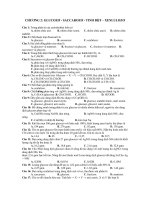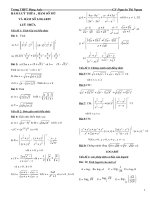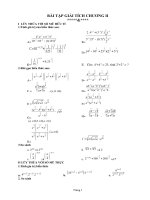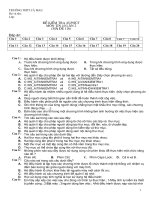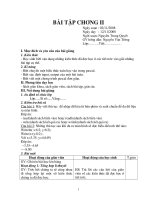Bài tập Chương 2
Bạn đang xem bản rút gọn của tài liệu. Xem và tải ngay bản đầy đủ của tài liệu tại đây (215.85 KB, 8 trang )
<span class='text_page_counter'>(1)</span><div class='page_container' data-page=1>
CHAPTER 2. PARTIAL DERIVATIVES
2.1. Functions of Several Variables
<i>1-10 Find and sketch the domain of the function </i>
1. ( , ) = 2 −
2. ( , ) = ln(9 − − 9 )
3. ( , ) = √1 − − 1 −
4. ( , ) = + 25 − −
5. ( , ) =
6. ( , ) = arcsin( + − 2)
7. ( , ) =
8. ( , ) = −
9. ( , , ) = 1 − − −
10. ( , , ) = ln(16 − 4 − 4 − )
<i>11-20 Sketch the graph of the function </i>
11. ( , ) = 1 +
12. ( , ) = 2 −
13. ( , ) = 10 − 4 − 5
14. ( , ) =
15. ( , ) = + 1
16. ( , ) = 1 + 2 + 2
17. ( , ) = 9 − − 9
18. ( , ) = 4 +
19. ( , ) = 4 − 4 −
20. ( , ) = sin( )
<i>21-30 Draw a contour map of the function showing several level curves</i>
21. ( , ) = ( − 2 )
22. ( , ) = −
23. ( , ) = √ +
24. ( , ) = ln( + 4 )
25. ( , ) =
26. ( , ) = sin
27. ( , ) = −
28. ( , ) = /( + )
29. ( , ) = cos
30. ( , ) = /
2.2. Limits and Continuity
<i>1-10 Find the limit of f(x, y) as (x, y) → (0, 0), if it exists, or show that the limit does not exist </i>
1. ( , ) =
2. ( , ) =
3. ( , ) =
4. ( , ) =
5. ( , ) =
6. ( , ) =
7. ( , ) =
8. ( , ) =
9. ( , ) =
10. ( , ) =
<i>11-20 Find the limit, if it exists, or show that the limit does not exist </i>
11. lim
( , )→( , )(5 − )
12. lim
( , )→( , )
13. lim
( , )→( , ) cos( + )
14. lim
( , )→( , )ln
15. lim
( , )→( , )
( )
16. lim
</div>
<span class='text_page_counter'>(2)</span><div class='page_container' data-page=2>
17. lim
( , )→( , )
18. lim
( , , )→( , , )
19. lim
( , , )→( , , )
20. lim
( , , )→( , , )
<i>21-30 Determine the set of points at which the function is continuous. </i>
21. ( , ) =
22. ( , ) = cos 1 + −
23. ( , ) =
24. ( , ) =
25. ( , ) = ln( + − 4)
26. ( , , ) = arcsin( + + )
27. ( , , ) = − ln
28. ( , , ) =
29. ( , , ) = ( , ) ≠ (0,0)
1 ( , ) = (0,0)
30. ( , , ) = ( , ) ≠ (0,0)
0 ( , ) = (0,0)
2.3. Partial Derivatives
<i>1-10 Find the first partial derivatives of the function </i>
1. ( , ) =
2. ( , ) =
3. ( , ) =
4. ( , ) =
5. ( , ) =
6. ( , ) =
7. ( , ) = ∫ cos
8. ( , ) = ∫ ln(1 + )
9. ( , ) = ∫
10. ( , ) = ∫ <sub>√</sub>
<i>11-20 Use implicit differentiation to find ∂z/∂x and ∂z/∂y </i>
11. + + =
12. + + = 1
13. = 1
14. sin( + + ) = 1
15. cos( ) + cos( ) + cos( ) = 1
16. = + +
17. ln( + ) =
18. + = 1
19. sin + sin + sin = 1
20. + ln =
<i>21-30 Find all the second partial derivatives </i>
21. ( , ) = + 2
22. ( , ) = sin ( + )
23. ( , ) = +
24. ( , ) =
26. ( , ) =
27. ( , ) = arctan
28. ( , ) = ln( + + 1)
</div>
<span class='text_page_counter'>(3)</span><div class='page_container' data-page=3>
2.4. Tangent Planes and Linear Approximations
<i>1-10 Find an equation of the tangent plane to the given surface at the specified point </i>
1. = 3 − 2 + , (2, −1, −3)
2. = 3 + 2 + 7, (1, −1,8)
3. = sin( + ) , , , 1
4. = + , (3,4,5)
5. = , (1,1,1)
6. = , (2,0,2)
7. = sin( + ) , (−1,1,0)
8. = ln( − 2 ) , (3,1,0)
9. = sin + sin , (0,0,0)
10. = sin + sin , , 0,1
<i>11-12 Graph the surface and the tangent plane at the given point. (Choose the domain and </i>
<i>viewpoint so that you get a good view of both the surface and the tangent plane.) Then zoom </i>
<i>in until the surface and the tangent plane become indistinguishable. </i>
11. = + + 3 , (1, 1, 5) 12. = arctan( ), (1, 1, /4)
<i>13-14 Draw the graph of and its tangent plane at the given point. (Use your computer algebra </i>
<i>system both to compute the partial derivatives and to graph the surface and its tangent plane.) </i>
<i>Then zoom in until the surface and the tangent plane become indistinguishable. </i>
13. ( , ) = ( ), (1, 1, 0)
14. ( , ) = √ + + , (1, 1, 3 . )
<i>15-20 Explain why the function is differentiable at the given point. Then find the linearization </i>
<i>L(x, y) of the function at that point. </i>
15. ( , ) = 1 + ln( − 5) , (2, 3)
16. ( , ) = , (1, 1)
17. ( , ) =
, (2, 1)
18. ( , ) = √ + , (3, 0)
19. ( , ) = cos , ( , 0)
20. ( , ) = + sin( / ) , (0, 3)
<i>21- 26 Find the differential of the function</i>
21. = cos 2
22. = + 3
23. =
24. =
25. = cos
26. =
27. If = 5 + and (x, y) changes from (1, 2) to (1.05, 2.1), compare the values of Δz
and dz.
</div>
<span class='text_page_counter'>(4)</span><div class='page_container' data-page=4>
29. The length and width of a rectangle are measured as 30 cm and 24 cm, respectively, with
an error in measurement of at most 0.1 cm in each. Use differentials to estimate the
maximum error in the calculated area of the rectangle.
30. Use differentials to estimate the amount of metal in a closed cylindrical can that is 10 cm
high and 4 cm in diameter if the metal in the top and bottom is 0.1 cm thick and the metal
in the sides is 0.05 cm thick.
2.5. The Chain Rule
<i>1-10 Use the Chain Rule to find du/dt. </i>
1. = + + , = sin , =
2. = cos( + 4 ) , = 5 , = 1/
3. = 1 + + , = sin , = cos
4. = tan ( / ) , = , = 1 −
5. = / <sub>+</sub> / <sub>, = cos</sub> <sub>,</sub> <sub>= sin</sub>
6. = − − , = cos , = sin
7. = / <sub>,</sub> <sub>=</sub> <sub>,</sub> <sub>= 1 − , = 1 + 2</sub>
8. = ln + + , = sin , = cos , = tan
9. = ( + ) , = cos , = sin
10. = , = cos , = sin
<i>11-20 Use the Chain Rule to find ∂z/∂s and ∂z/∂t. </i>
11. = , = cos , = sin
12. = arcsin( − ) , = + , = 1 − 2
13. = sin cos , = , =
14. = , = / , = /
15. = cos , = , = √ +
16. = tan( / ) , = 2 + , = 2 − 3
17. = + + 1, = cos , = sin
18. = , = + , = −
19. = cos( + ) , = 2 − 3 , = 3 + 2
20. = sin cos , = , =
2.6. Directional Derivatives and the Gradient Vector
<i>1-10 Find the directional derivative of f at the given point in the direction of the indicated vector. </i>
1. ( , ) = + 4 , (2, 1), = 〈 ,√ 〉
</div>
<span class='text_page_counter'>(5)</span><div class='page_container' data-page=5>
3. ( , ) = + 4 , (2, 1), = 〈 , −√ 〉
4. ( , ) = − 4 , (2, −1), = 〈
√ ,√ 〉
5. ( , ) = + , (3, −4), = 〈1,0〉
6. ( , ) = − , (4, 3), = 〈1,0〉
7. ( , ) = ( − ) − 4 , (2, −1), = 〈
√ ,√ 〉
8. ( , ) = ln(1 + + ) , (0, 0), = 〈1,0〉
9. ( , ) = cos(2 − ) , (0, 0), = 〈0,1〉
10. ( , ) = cos(2 − ) , (0, 0), = 〈1,0〉
<i>11-20 Find the directional derivative of f at the given point in the direction indicated by the angle θ. </i>
11. ( , ) = + , (1, 1), = /6
12. ( , ) = , (0, 4), = 2 /3
13. ( , ) = cos , (0, 0), = /4
14. ( , ) = y sin + sin , (0, 0), /3
15. ( , ) = − 4 , (2, 1), = /6
16. ( , ) = + , (1, −1), = /4
17. ( , ) = 1 − − , (0,0), =
18. ( , ) = sin( + ) , (0,0), = /3
19. ( , ) = , (1, 1), = /2
20. ( , ) = − , (1, 1), = /2
21-24
(a) <i>Find the gradient of f. </i>
(b) Evaluate the gradient at the point P.
(c) <i>Find the rate of change of f at P in the direction of the vector u </i>
21. ( , ) = sin(2 + 3 ) , (−6, 4), = 〈√3, −1〉
22. ( , ) = / , (1,2), = 〈2, √5〉
23. ( , , ) = − , (2, −1,1), = 〈0, , − 〉
24. ( , , ) = , (0,1, −1), = 〈 , , 〉
<i>25-30 Find equations of (a) the tangent plane and (b) the normal line to the given surface at </i>
<i>the specified point. </i>
25. 2( − 2) + ( − 1) + ( − 3) = 10, (3, 3, 5)
26. = − , (4, 7, 3)
27. = 6, (3, 2, 1)
28. + + = 5, (1, 2, 1)
29. + + = , (0, 0, 1)
30. + + = 3 , (1, 1, 1)
</div>
<span class='text_page_counter'>(6)</span><div class='page_container' data-page=6>
32. If ( , ) = + − 4 , find the gradient vector Δg(1, 2) and use it to find the tangent
line to the level curve g(x, y) = 1 at the point (1, 2). Sketch the level curve, the tangent line,
and the gradient vector.
33. Show that the equation of the tangent plane to the ellipsoid + + = 1 at the point
(x0, y0, z0) can be written as + + = 1
34. Find the equation of the tangent plane to the hyperboloid + − = 1 at (x0, y0, z0)
and express it in a form similar to the one in Exercise 33.
35. Show that the equation of the tangent plane to the elliptic parraboloid = + at the
point (x0, y0, z0) can be written as + =
36. At what point on the paraboloid = + is the tangent plane parallel to the plane +
2 + 3 = 1?
37. Are there any points on the hyperboloid − − = 1 where the tangent plane is
parallel to the plane = + ?
38. Show that the ellipsoid 3 + 2 + = 9 and the sphere + + − 8 − 6 −
8 + 24 = 0 are tangent to each other at the point (1, 1, 2). (This mean that they have a
common tangent plane at the point.)
39. Show that every plane that is tangent to the cone + = passes through the origin.
40. Show that every normal line to the sphere + + = passes through the center of
the sphere.
41. Where does the normal line to the paraboloid = + at the point (1, 1, 2) intersect
the paraboloid a second time?
42. At what points does the normal line through point (1, 2, 1) on the ellipsoid 4 + +
4 = 12 intersect the sphere + + = 102?
43. Show that the sum of the x-, y-, and z-intercepts of any tangent plane to the surface √ +
+ √ = √ is a constant.
44. Show that the pyramids cut off from the first octant by any tangent planes to the surface
xyz = 1 at points in the first octant must all have the same volume.
45. Find parametric equations for the tangent line to the curve of intersection of the paraboloid
= + and the ellipsoid 4 + + = 9 at the point (-1, 1, 2).
2.7. Maximum and Minimum Values
</div>
<span class='text_page_counter'>(7)</span><div class='page_container' data-page=7>
5. ( , ) = + 3 − 6 − 6 + 2
6. ( , ) = (1 − − )
7. ( , ) = − 12 + 8
8. ( , ) = + +
9. ( , ) = cos
10. ( , ) = cos
11. ( , ) = ( + )
12. ( , ) = ( − )
13. ( , ) = − 2 cos , −1 ≤ ≤ 7
14. ( , ) = sin sin , − < , <
<i>15-22 Find the absolute maximum and minimum values of f on the set D. </i>
15. ( , ) = + − 2 , D is the closed triangular region with vertices (2, 0), (0, 2) and (0, -2).
16. ( , ) = + − , D is the closed triangular region with vertices (0, 0), (0, 2) and (4, 0).
17. ( , ) = + + + 4, = {( , ) | | | ≤ 1, | | ≤ 1}
18. ( , ) = 4 + 6 − − , = {( , ) | 0 ≤ ≤ 4, 0 ≤ ≤ 5}
19. ( , ) = + − 4 + 2, = {( , ) | 0 ≤ ≤ 3, 0 ≤ ≤ 2}
20. ( , ) = , = {( , ) | 0 ≤ , 0 ≤ , + ≤ 3}
21. ( , ) = 2 + , = {( , ) | + ≤ 1}
22. ( , ) = − 3 − + 12 , D is quadrilateral whose vertices are (-2, 3), (2, 3), (2, 2),
and (-2, -2).
23. Find the shortest distance from the point (2, 0, -3) to the plane x + y + z = 1.
24. Find the point on the plane x – 2y + 3z = 6 that is closed to the point (0, 1, 1).
25. Find the point on the cone z2<sub> = x</sub>2<sub> + y</sub>2<sub> that are closest to the point (4, 2, 0). </sub>
26. Find the points on the surface y2<sub> = 9 + xz that are closest to the origin. </sub>
27. Find three positive numbers whose sum is 100 and whose product is a maximum.
28. Find three positive numbers whose sum is 12 and the sum of whose squares is as small as
possible.
29. <i>Find the maximum volume of a rectangular box that is inscribed in a sphere of radius r. </i>
30. Find the dimensions of the box with volume 1000 cm3<sub> that has minimal surface area. </sub>
31. Find the volume of the largest rectangular box in the first octant with three faces in the
coordinate planes and one vertex in the plane x + 2y + 3z = 6.
32. Find the dimensions of the rectangular box with largest volume if the total surface area is
given as 64 cm2<sub>. </sub>
33. Find the dimensions of a rectangular box of maximum volume such that the sum of the
<i>lengths of its 12 edges is a constant c. </i>
34. <i>The base of an aquarium with given volume V is made of slate and the sides are made of </i>
glass. If slate costs five times as much (per unit area) as glass, find the dimensions of the
aquarium that minimize the cost of the materials.
35. A cardboard box without a lid is to have a volume of 32.000 cm3<sub>. Find the dimensions that </sub>
minimize the amount of cardboard used.
</div>
<span class='text_page_counter'>(8)</span><div class='page_container' data-page=8>
per day, the floor at a rate of 1 unit/m2<sub> per day, and the roof at a rate of 5 units/m</sub>2<sub> per day. </sub>
Each wall must be at least 30 m long, the height must be at least 4 m, and the volume must
be exactly 4000m3<sub>. </sub>
(a) Find and sketch the domain of the heat loss as a function of the lengths of the sides.
(b) Find the dimensions that minimize heat loss. (Check both the critical points and the
points on the boundary of the domain.)
(c) Could you design a building with even less heat loss if the restrictions on the lengths of
the walls were removed?
2.8. Lagrange Multipliers
<i>1-14 Use Lagrange multipliers to find the maximum and minimum values of the function subject </i>
<i>to the given constraint. </i>
1. ( , ) = + ; = 1
2. ( , ) = 3 + ; + = 10
3. ( , ) = − ; + 4 = 4
4. ( , ) = ; + = 16
5. ( , ) = + ; + = 1
6. ( , ) = ; + = 1
7. ( , , ) = + + ; + + = 1
8. ( , ) = + ; + = 1
9. ( , , ) = 2 + 2 + ; + + = 9
10. ( , , ) = + + ; + + = 12
11. ( , , ) = ; + 2 + 3 = 6
12. ( , , ) = ; + + = 1
13. ( , , ) = + + ; + + = 1
</div>
<!--links-->



